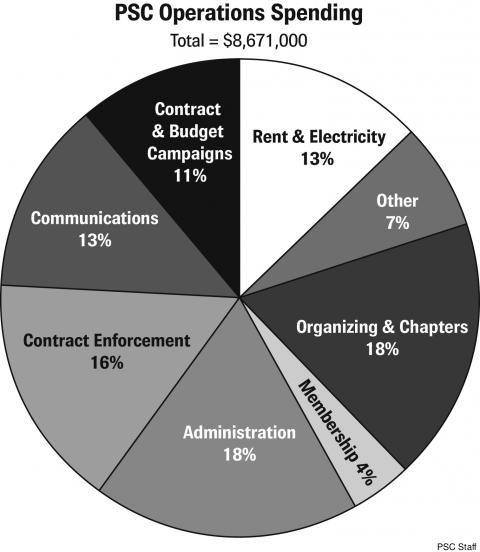Dues are a regular payment from members that fund their union. They finance crucial union operations like contract negotiations and enforcement, organizing, and member-driven programs. It's one of the most common questions about unionizing so let's break down the basics.
What are typical union dues?
Elected officials of the union set union dues and typically hover around 1-2%. The most common structure sets dues as a percentage of gross earnings. If dues are 1%, workers pay $1 for every $100 earned. Members of the International Federation of Professional and Technical Engineers Local 21 pay 0.963% while members of AFSCME Council 13 in Pennsylvania pay 1.5% of earnings, excluding overtime. Unions may establish a multi-tiered or sliding scale dues structure, like International Brotherhood of Electrical Workers while others - like the Plumbers and Pipefitters Local 145 - pay a flat monthly amount (in their case $40 per month).
When do I pay dues?
In a newly organized workplace, workers pay dues only after there is a first union contract in place. It’s not up to the bargaining committee or management or union staff - the contract only goes into effect once it is ratified (voted on) by members. Why would you vote “yes” on a contract that isn’t worth the cost of dues?
If there is already a contract in place, anyone hired into a union position is covered by benefits and protections of the union contract from day one. Dues aren’t deducted until the worker signs paperwork that authorizes dues deduction and elects membership or fee paying status.
How are dues typically paid?
Most union employees are on “dues checkoff”: dues are deducted directly from each paycheck and sent by the employer directly to the union office. You’ll see the amount dedicated on each paystub along with other proportionate deductions (like taxes or insurance). Dues checkoff may not be possible for a workforce with irregular paychecks - anyone from television writers to construction workers- in which case dues are paid directly to the union.
Fortunately there are a lot more options today than going to the union hall to pay dues in-person.

What do dues pay for?
Dues pay for all union operations, everything from staff salaries to office rent to arbitration costs. Union staff includes not only contract negotiations and enforcement but a range of needs like administration, communications, new organizing, and member trainings. Many unions reserve a portion of the budget for a strike fund which goes directly to workers in the event of a strike.
Depending on the union, there are additional budget items. Some unions manage their own benefit plans while others provide extensive training programs. Unions that are part of the AFL-CIO pay a “per capita tax” per member to contribute to national labor political work and education. Locals - distinct chapters within a large national or international union - contribute a percentage of membership dues to the national or international office. Many unions have separate PACs that are funded by voluntary contributions for lobbying and electoral efforts.
How do I see what my union is spending money on?
Unions are subject to significant oversight, including a requirement to submit annual financial reports to the Office of Labor Management Standards, a department of the Department of Labor (DoL). Unions with an annual budget of over $250,000 must submit a form annually called an LM2, which are publicly searchable online. In addition to these requirements, unions also provide annual reports to their members.

Why are dues worth it?
Dues are an investment in your future. Early 2020 reports cited an average 3.8% salary increase in first contracts (which more than covers dues); over a lifetime union members earn 20% more than their non-unionized counterparts. That’s just looking at take-home pay and doesn’t account for the overall economic value of union membership (benefits like health insurance and paid leave) or the intangible value of representation and a voice in the workplace. On a national level, declining union membership over the last few decades is directly related to the rise in income inequality.



